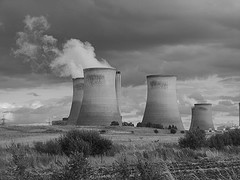 Nuclear power and ecologically-minded people – they have never been the best of friends. In fact, nuclear power can be seen as the malevolent midwife of the modern green movement. It first became a coherent force in opposition to it. It was in the 1970’s that the risks of nuclear power plants first became apparent. And those concerns crystallized a moment of unease with the idea that all technological progress was inevitably good. So nuclear power came to be seen as ‘messing about with nature’ – the nemesis of the new green ideal of a ‘balance with nature’, where we were no longer her master.
Nuclear power and ecologically-minded people – they have never been the best of friends. In fact, nuclear power can be seen as the malevolent midwife of the modern green movement. It first became a coherent force in opposition to it. It was in the 1970’s that the risks of nuclear power plants first became apparent. And those concerns crystallized a moment of unease with the idea that all technological progress was inevitably good. So nuclear power came to be seen as ‘messing about with nature’ – the nemesis of the new green ideal of a ‘balance with nature’, where we were no longer her master.
But since then, new threats have reared up from our relentless technological bag of tricks – and now climate change, not nuclear meltdown, is the bugbear that threatens life on the planet. And as that threat has become more of a damaging reality, than a far off possibility, so the urgency of dealing with greenhouse gas emissions has caused something of a rethink. Maybe, some say, nuclear power can be part of the solution to global warming – and we should bring it into the green fold.
If you look at the issue calmly and rationally – which doesn’t always happen with a power source associated with nuclear meltdown and radiation sickness – there is a case to be made. First and foremost, it has zero ‘tailpipe emissions.’ Nuclear power stations don’t directly produce any greenhouse gases, and that makes its electricity squeaky clean, on that front at least. Secondly, nuclear power is deployed in the ‘here and now’ – not like pie-in-the-sky renewables, which have only recently clawed up to meeting 2% of the world’s energy needs.
So nuclear can start making a contribution to reducing emissions straight away. It’s a technology that is known to work, and isn’t as erratic or flaky as wind and solar sources. And to top it off, nuclear power is relatively cheap. With the painfully slow progress so far, towards a zero-carbon economy, it’s no wonder that many in the green movement were won over by the urgency of the situation, and became pro-nuclear. Then the plates moved off the coast of NE Japan.
In a few dramatic days, the world – and environmentalists in particular – were reminded of why nuclear power is playing with fire, as reactors at Fukushima took turns in blowing their tops off. Despite the best efforts of site workers, dangerous leaks of radiation entered both the atmosphere, and the sea. Suddenly, the reason why nuclear power had such a bad green reputation became very apparent. Radiation can be released uncontrollably from damaged nuclear plants, causing cancer, and sowing mutation – and it can persist for thousands, if not millions of years.
Of course, there is a counter-attack to this knee-jerk abhorrence of what happens when nuclear power plants go bad. If you tot up all the deaths and illnesses from nuclear power accidents, from Three Mile Island, to Chernobyl, up to the new black mark of Fukushima, they’re still very low in comparison to projections for global warming. The utilitarian trend will put those numbers through their calculators, and come back with a positive cost-benefit analysis. Nuclear power can still be a good green solution.
But they are ignoring some very important factors, which go beyond a simple ‘bean-counter’ mentality. First, nuclear power requires uranium, and as a resource, the amount of exploitable uranium is limited. At some point it will run out, and we’ll be back to square one. Secondly, in order for nuclear power to replace ‘dirty’ power generation, it will need huge resources thrown at it – which will divert us from changing towards renewables. When we run out of fuel for nuclear power plants, the resource won’t be there to build a renewables energy sector.
And thirdly, nuclear power scares people. No amount of rational talk will change the gut feeling about making energy from radioactive elements. We don’t like the fact that nuclear waste can cause sickness, mutation and death for hundreds of thousands of years after. We don’t like the fact that nuclear power plants can blow up, and render hundreds of square kilometers unlivable. And we don’t like the fact that scientists are always reassuring about risks being well-known. It’s the unknown risks we’re really scared about. And if green is about feeling good about how man works with the natural world, then an energy source that scares people can never truly be considered as green.
This is a guest post by Johnson, owner of a free website offering tips on how to build muscle.
Photo: ![]()
![]() Some rights reserved by xueexueg
Some rights reserved by xueexueg
[…] Will nuclear power ever be green?Eco Child’s PlayNuclear power and ecologically-minded people – they have never been the best of friends. In fact, nuclear power can be seen as the malevolent midwife of the modern green movement. It first became a coherent force in opposition to it. …Q+A-What's going on at Japan's damaged nuclear power plant?ReutersEarthquakes and nuclear powerWTNHMore water injection starts at Japan troubled nuclear plantMonsters and Critics.comKyiv Post -Appleton Post Crescent -Sifyall 886 news articles » […]